BeoVision 901
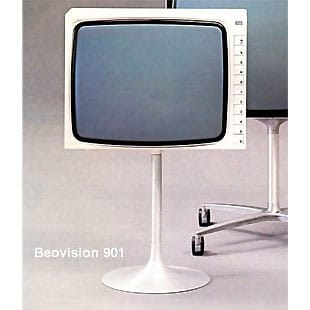
Beovision 900 and 901 TV sets were 50cm monochrome televisions manufactured between the years 1971 and 1976.

Beovision 900 and 901 TV sets were 50cm monochrome televisions manufactured between the years 1971 and 1976.
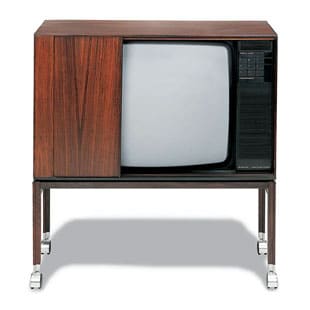
Beovision 6000 was a luxurious colour TV receiver with a 66cm screen and cordless, ultrasonic remote control (designed by David Lewis).
The slim remote control module allowed you to select up to eight TV programmes, adjust volume, brightness and colour strength from the correct viewing and listening position. You could also switch the set off without moving away from your armchair. The ‘recall’ facility provided a digital on-screen display indicating the channel currently being viewed. The reset function automatically returned volume, colour and brightness to pre-set levels.
Beovision 6000 was the first TV with dedicated remote control. Successor to the Beovision 3000 (1967) which was Bang & Olufsen’s first colour TV. The design of the TV set itself was by Henning Moldenhawer.
Picture quality was outstanding, with sharp, bright, precise image definition and natural colours. The automatic cut-off circuit monitored the balance of colours fifty times a second, guaranteeing long-term colour truth.
Sound reproduction was of hi-fi quality because Beovision 6000 was fitted with a 6,5 watts RMS amplifier which had a wide frequency range and less than 0,8% harmonic distortion. The loudspeaker was of a pressure-chamber construction as used in many hi-fi audio systems. There were separate controls for bass and treble and sockets for connecting headphones and additional speakers. The receiver could also be equipped with a module for Teletext reception and video cassette programmes could be reproduced without additional technical adjustment.
Beovision 6000’s genuine wood-finished cabinet had a unique tambour screen door for protecting the screen when the set was not in use. The self-styled wooden undercarriage with smooth-running castors was both practical and elegant.
Beovision 6000 was replaced by Beovision 6002 in 1977, again with the same stylish cabinet and sliding, tambour door.
Henning Moldenhawer (Beomaster 900 designer) once dubbed the concept of remote control Terminals as “feel commanders”. This meant that the product could be operated by the thumb on one hand – almost as if the user was feeling his way through a new type of Braille, allowing the eye to concentrate on the TV picture itself.
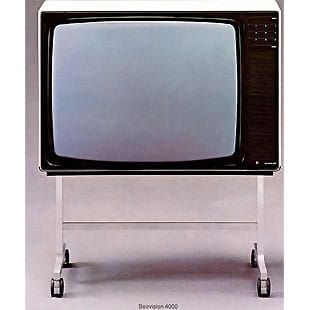
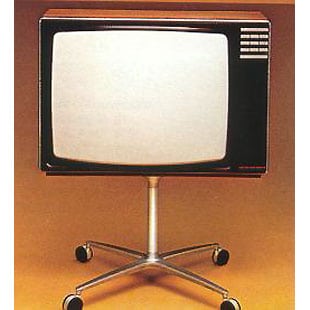
Beovision 4002 and 4402 were colour receivers with 26″ screens. Natural colours, sharp, precise image definition and high-fidelity sound reproduction are all features you can take for granted, according to the 1970 – 80 Bang & Olufsen product catalogue. Their high reliability levels were due to modular construction techniques and low heat-generation. Beovision 4002 consumed only 110 watts – less than a black and white set of years previously.
Both sets were extremely easy to use. There were facilities for presetting up to eight stations so that subsequent programme selection was just a matter of pressing one button. This turned the set on at the same time.
Beovision 4402 had the additional convenience of a cordless (ultrasonic) remote control. The set could also be supplied equipped for Teletext reception. There was automatic synchronisation of VCR programmes on all channels.
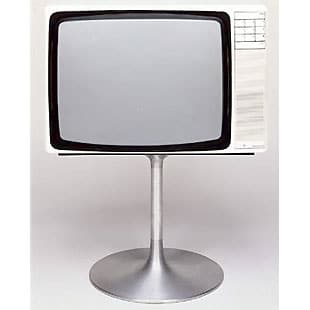
Beovision 3500 type number: 3907 was a 56cm colour television designed by David Lewis and Henning Moldenhawer. It could be placed on two types of stand – the trumpet stand (shown above) and the cross foot stand.
By 1975, colour television had become commonplace in homes throughout Western Europe. And a lot of those homes were furnished in white – the ‘in’ colour of the 1970s. Television, as a lot of home furnishings, followed this trend and Beovision 3500, with its trumpet base and cross-base on wheels, reflected what was happening in the world of interior design. The cabinet was made of moulded plastic and its appearance was markedly different from most other televisions of the era.
Beovision 3500 was Bang & Olufsen’s first fully transistorised television; this meant that very little warm up time was necessary for picture and sound. The choice of television channels had increased considerably over the previous years and the controls were adapted accordingly. “In everyday use, you select your TV programmes using the easy-touch push buttons at the top. Each of these can be set to one TV channel; this is done once only using the scaled potentiometer dials. These eight dials are only visible when the panel is opened; this is where you or your dealer can set the VHF and UHF channels that you are able to receive. Beovision 3500 has automatic frequency control, AFC, which locks the TV stations once they have been selected.” said the sales literature in 1975.
With Beovision 3500 it was clear that an icon had been created. The cabinet was made of moulded plastic and its appearance was markedly different from most other televisions of the time. However, the wooden cabinet was retained in the similarly-styled Beovision 3600 model. From 1975, Bang & Olufsen was also able to equip all its televisions with Automatic Cut-off Control.
An invention by the young engineer Erik Albert Jensen made waves internationally in the television sector. Cut-off Control ensures that the colour balance is maintained throughout the service life of the television. No fewer than 50 times each second the three electron beams are measured and corrected independently, thus avoiding any annoying deviations in colour.
(Taken from Beolink Magazine: ‘The First 50 Years of Television’ © Bang & Olufsen a/s 2002)
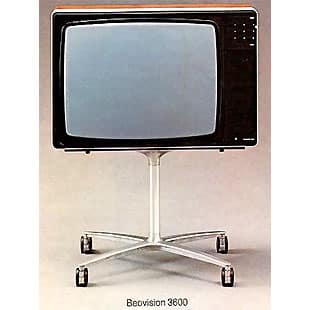
Beovision 3600 type number: 3908, 3909, 3938 was a 56cm colour television with a wooden surround.
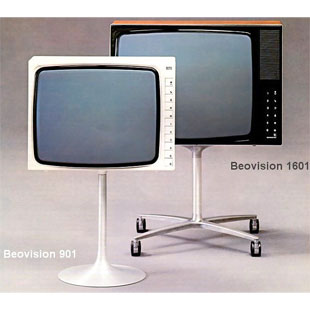
The Beovision 1600 replaced the Beovision 1400 range and included a new all-transistor chassis. As before, a 24” wide-angle tube was fitted, the largest monochrome tube that was available at the time. In contrast to the 1400 range, only one cabinet style was available, a table model, though this could be fitted with an optional pillar stand for free-standing use. The design was simple and elegant, with the minimum of cabinet work around the screen.
The controls were all of a new design, and concealed when not in use. Each one was mounted in a small latching drawer marked with a graphical symbol to represent its function. To adjust a setting (volume, brightness etc), one only had to touch the relevant drawer lightly and it would open, allowing access to an edgewise rotary control. The tuning worked in a similar manner, where the tuning controls were hidden inside the channel selector buttons. To adjust the tuning, one would press the button one wished to adjust, thus selecting the channel, then press again to slide out the drawer to reveal the tuning scale and control.
To make the most of the instant picture possibilities that the adoption of transistors (instead of the valves in previous models) offered, the heater of the picture tube of the Beovision 1600 was left energised at all times. In order to extend the life of the tube, when the set was switched “off”, the heater was run at a slightly lower level of power. Even despite this, the picture appeared truly instantly as soon as the “on” button was pressed, something that no other range of Beovision TV sets has been capable of since.
The rest of the design was quite conventional, with the exception of the voltage regulator which could tolerate a very wide range of mains voltages without picture disturbance.
The Beovision 1600 was the last large-screen monochrome Beovision model

This was B&O’s first remote control, predating the Beomaster 2400. Known affectionately as the brick, it was very necessary as setting up a quad system required to be sitting at the centre of the four speakers. It allowed control of the volume and Beomaster source though it was not able to control any device except the Beomaster. It used ultrasonic rather that infra red waves and needed to be aimed at the Beomaster.
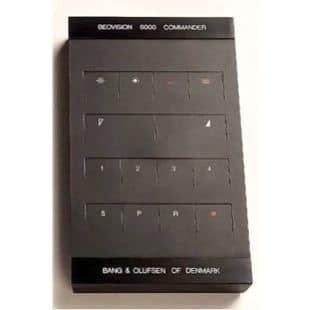
A very similar design to the Beomaster 6000 Commander, this was an ultrasound remote control for the top of the range Beovision 6000.
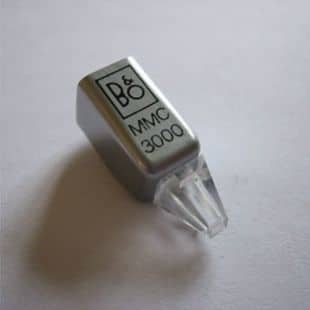
The MMC3000 was the basic model in the all new range of cartridges.
It was designed for use with the lower end of the range such as the Beogram 1100 and Beocenter 1800 and 3600. It has a spherical diamond stylus.